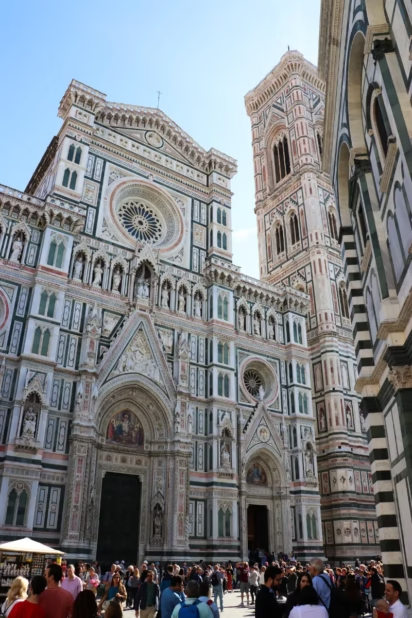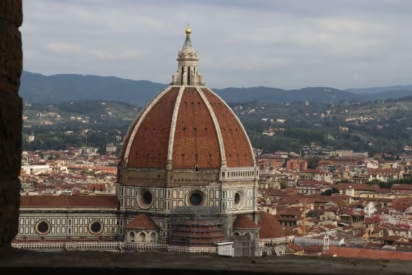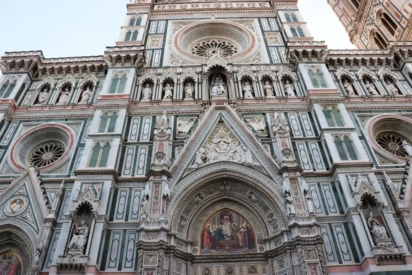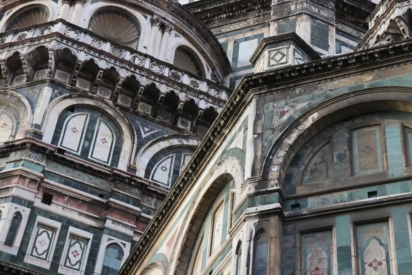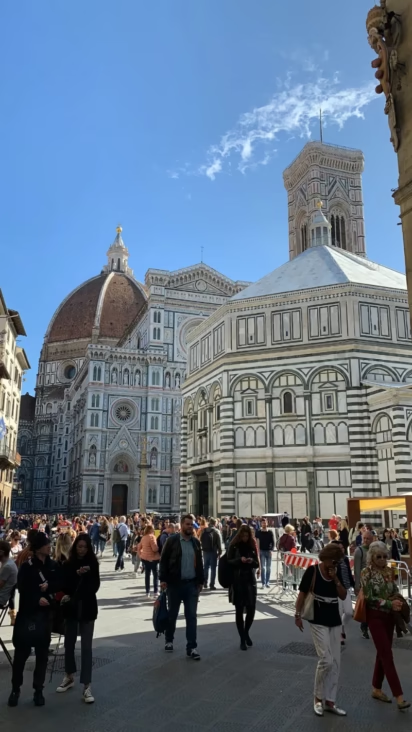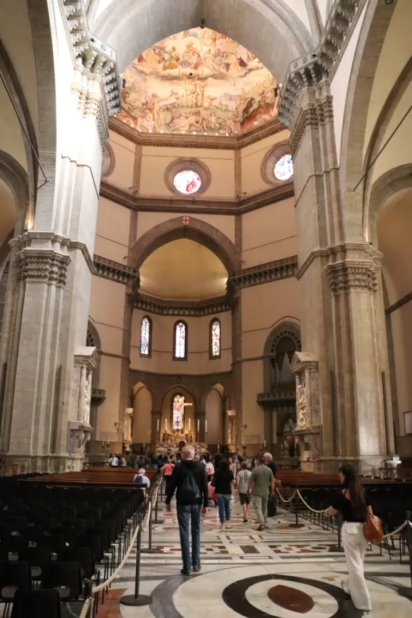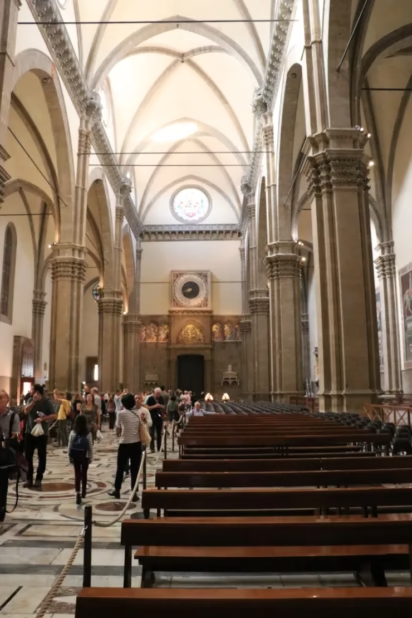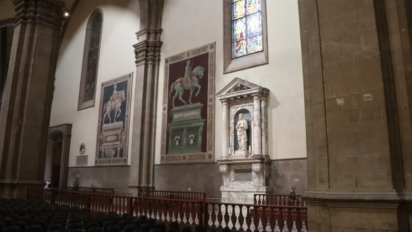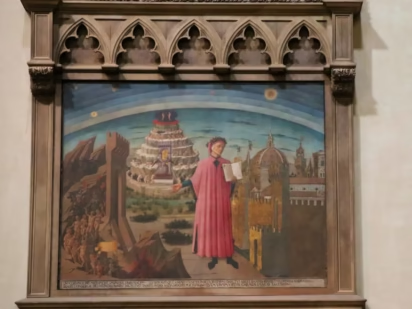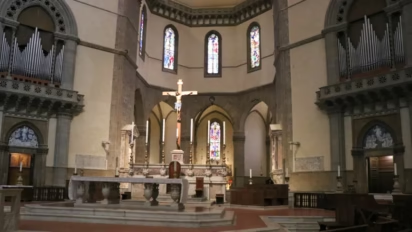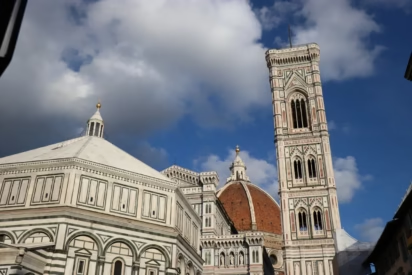The exterior of the Cathedral of Florence (Duomo di Firenze) is often more impressive than a visit to the large Gothic church interior, which is free and seen without tickets or time-slot reservations.

The Duomo di Firenze with its famous dome is the symbol of Florence. This large cathedral dominates and beautifies the skyline from almost all vantage points. Its Gothic exterior is clad in white, green, and pink marble with a magnificent tiled dome its shining glory. The slightly too perfect western facade is late nineteenth-century neo-Gothic. The huge interior is somewhat disappointing and doesn’t warrant the time many visitors spent queuing to enter. Admission is free with no timeslot reservation option to skip the slow-moving security lines. Guided tours give skip-the-line access to the cathedral and often include further sights such as climbing the cupola, or visiting the baptistery and Duomo museum.
Building of the Gothic Florence Cathedral
The Cathedral of St Mary of the Flower (La cattedrale metropolitana di Santa Maria del Fiore), usually simply referred to as the Duomo, is the largest church in Florence. On its completion in 1436, it was the largest in the world and it remains one of the largest churches in Christianity. The “flower” in the name came from the Roman goddess Flora, the female protector that gave the city its name.
Construction of the Gothic cathedral started in 1296 to replace the older and much smaller St Reparata church. The new church was originally designed by Arnolfo di Cambio but enlarged in reworked plans, as construction took nearly a century and a half under numerous building masters.
Work dragged on and at times came to a standstill. Giotto took charge from 1334 for three years. He concentrated on the campanile (and did a very fine job!) to quickly produce an architectural focal point to reflect the growing importance (and self-awareness) of 14th-century Florence.
The plague of 1348 that halved the population of Florence also caused a long break in construction. However, by 1360 the bell tower was largely completed, as was the nave by 1380.
Problem of the Dome of the Duomo in Florence
The cathedral was designed to be the biggest church in the world but from an architectural (and engineering) point of view, the large dome required was more problematic. By 1418 most of the walls for the drum of the dome were completed. However, no clarity existed on how to actually build the cupola.
The magnificent cupola was famously finished by Brunelleschi, as an architectural masterpiece marking the transition from the Gothic to the Renaissance. With a diameter of 45.52 m (147 ft) on the diagonal, it was the largest dome in the world from its completion in 1436 until 1871. It remains the largest brick dome to the present.
→ See Climbing Brunelleschi’s Cupola for more on the construction history of this remarkable work of art, architecture, and engineering.
Neo-Gothic Facade of the Duomo in Florence
The current neo-Gothic facade of the Duomo was designed by Emilio de Fabris and completed only in 1887. Previously, only around half of the original Gothic facade was installed before being taken down in the late 16th century. (The sculptures and models of this facade are in the museum.)
The intended more modern Renaissance facade was never built and apart from temporary facades, the western end of the church remained bare for centuries similar to San Lorenzo, which has a wonderful Renaissance interior partly designed by Brunelleschi but a rather dull faceless facade.
In the late 19th century, when Italy was finally uniting into a single political entity, Florence was briefly the capital of the new kingdom. Several grandiose building projects followed including finally completing a new facade for the cathedral. Inevitably, some criticized the neo-Gothic design but the quality of the workmanship is good. After nearly 150 years there are no real demands by anyone to tear it down again.
Architecture and Measurements of the Duomo in Florence
The cathedral of Florence follows a fairly typical Gothic Latin cross basilica layout of a taller central nave with two narrower side aisles and a protruding transept. However, rather than the conventional transept nave, the transept and choir end in rounded apses formed by the five sides of an octagon.
The Duomo in Florence was designed to be the largest church in the world and was the largest in the world at the time of its completion in 1436. Many other cities in Italy also planned this honor — Florence was unambitious compared to uncompleted projects in for example Siena and Bologna, where finance halted the megalomaniac projects long before the laws of gravity could interfere.
The measurements of the cathedral in Florence (Duomo di Firenze):
- Building area: 8,300 square meters (89,340 sq ft)
- External length: 160 m (525 ft)
- External height of the nave roof: 43 m (141 ft)
- Interior length: 153 m (502 ft)
- Interior width: 38 m (125 ft)
- Transept: 90 m (300 ft)
- Interior height of the vaulting of the central nave: 35 m (115 ft)
- Interior height of the side aisles: 23 m (75 ft)
- Interior height of the cupola: 90 m (295 ft)
- External height of the cupola: 114.5 m (375.7 ft) (including the 21 m (69 ft) of the lantern)
- Interior width of the dome: 45.52 m (147 ft)
- Height of the campanile: 84.7 m (278 ft)
- The interior has room for around 30,000 people.
Depending on who (and what) is measuring, the duomo is the third-largest church in the world behind St Peter’s in Rome and St Paul’s in London by the length of the nave and the fifth by area of constructions behind St Peter’s, St Paul’s and the cathedrals in Milan and Seville.
Interior of the Duomo in Florence
The interior of the duomo is stark, a bit dark, and empty. Much of the art was lost through the centuries or moved into the museum. It is in no way the same art-filled tour de force of other famous cathedrals in the region such as Pisa and Siena. Most other churches in Florence requiring entrance tickets, e.g. Santa Maria Novella, Santa Croce, or San Lorenzo, and many free ones too, have more art on display.
The floor has interesting geometric patterns with much of the marble tiling surviving from the 16th century. However, these patterns are best appreciated from the ring walk around the drum of the dome, so do make sure to look into the church nave too and not only at the ceiling painting, if climbing to the lantern on top of Brunelleschi’s dome (highly recommended).
Top Artworks in the Duomo in Florence
A few artworks to pay special attention to inside the Duomo in Florence include:
Best Paintings
Three notable works are on the wall of the north aisle (left) and are still in the church rather than the museum probably due to being frescos:
Closest to the western end are two frescoes of equestrian statues: the Funerary Monument to Sir John Hawkwood (1436) by Paolo Uccello and the Equestrian Statue of Niccolo da Tolentino (1456) by Andrea del Castagna. Both artists struggled with the rules of perspective by using different focal points for the pedestal and horse.
The painting of Dante Before the City of Florence (1465) by Domenico di Michelino shows Dante explaining scenes from his Divine Comedy in front of a Florence that the poet would be totally unfamiliar with. Dante died in 1321 — about a century before the construction of the cupola started. The Florence he pined for was in no way the Renaissance and Medici art-dominated center that attracts visitors to Florence in later centuries. (Dante’s cenotaph in Santa Croce remains empty. Even in death the poet, who died in Ravenna, never returned to his beloved Firenze.)
Other Artworks
Paolo Uccello painted the large clock (1443) on the western end of the nave. It is still working and uses the 15th-century habit of placing the 24th hour of the day at sunset.
The blue and white terracotta above the doors at the sacristy is by Luca della Robbia (around 1440). Painted terracotta was more popular in Florence during the Renaissance than white marble. (Fine examples are on display in the Bargello Museum.)
Other works by famous artists are now mostly inside the museum. The sculptures and decorations in the choir and transept areas are interesting but often blocked off to visitors.
The current organ is from 1961 (expanded in 1991) by Vincenzo Mascioni with 107 stops and 6761 pipes. It has three consoles allowing the instrument to be played as five independent organs in five different parts of the cathedral.
Stairs lead down to the crypt with some archaeological remains from the original Santa Reparata church as well as the tomb of Brunelleschi. (Admission to the crypt is included in all ticket passes. Passholders may usually skip the lines waiting to enter the Duomo by using a side entrance near the bell tower.)
Vasari’s Dome Ceiling Painting in the Duomo in Florence

Brunelleschi would have liked the interior of his dome to shimmer with the sparkle of golden mosaics or paint but his wishes were never fulfilled or seriously contemplated on cost grounds. The interior of the dome was simply whitewashed until the late 16th century.
The famous art historian (and gossip) Giorgio Vasari (1511-1574) designed the Last Judgement fresco 1572-9 to cover the 3,600 square meters (38,750 sq ft) ceiling of the dome. Vasari intended a work more impressive than Michelangelo’s Sistine Chapel fresco but failed similarly to Michelangelo’s inability to improve on Brunelleschi’s dome. (At least Michelangelo had the good sense to announce well in advance that St Peter’s dome will be taller but not more beautiful than Brunelleschi’s cupola.)
By the time of his death, Vasari had painted only a very small part of the fresco (a few of the elders near the lantern). Most of his design was completed after his death by less talented painters led by Federico Zuccari, who often painted on dry rather than wet mortar. They even managed to get a few limbs wrong but given the ferocity of the beasts of hell, it is hard to determine if it was intentional or not.
Vasari’s painting has been criticized both for its design and the quality of the art. The painting makes the dome appear lower rather than letting it soar into the sky. Many thought a return to the whitewash would have been a better investment than the money spent on a very expensive restoration project at the end of the 20th century.
Best Close-Up Views are from the Drum Ring

However, the painting is easy to enjoy. The main scene visible from the nave is the Last Judgement. At the opposite end is the three-faced devil stuffing humans into his three mouths. The main scenes in rings from the lantern down: the 24 Elders, Choirs of Angels, Christ, Mary and Saints, the Virtues, and finally the Capital Sins and Hell. See the popular latter ring from the walkway at the top of the drum when visiting the cupola. The painting has an incredible number of bare buttocks — not only in hell — while full-frontal nudity is used more sparingly.
Some of the around 1500 cracks in the dome are visible from floor level. The first cracks already appeared during the construction of the cupola and it is now constantly monitored.
Stained Glass Windows of the Duomo di Firenze
Although the Duomo has with 44 stained-glass windows the largest collection from the 14th and 15th centuries in Italy, the interior works surprisingly dark for a Gothic church. The number of windows in the nave is limited and some glass is blocked off. Even the choir in no way resembles the brightly lit interiors of French (or even German) Gothic churches.
The windows include designs by such notable Florentine artists as Lorenzo Ghiberti, Paolo Uccello, Andrea del Castagno, Donatello, and Gaddi. The Coronation of the Virgin — the only window in the drum easily seen from the nave — is by Donatello. The large circular window in the western facade of the same scene is by Gaddo Gaddi (early 14th century).
Visitor Information for the Duomo in Florence
The interior of the large cathedral is certainly worth seeing but many will be disappointed by the lack of art, and that many parts of the choir area are cordoned off to casual visitors. If the slow-moving security queues are long, the required waiting time is often better spent elsewhere in Florence. A quick look into the church when climbing the dome may be sufficient for many, or if open, use the side entrance en route to Santa Reparata.
There are no individual skip-the-line tickets for entering the Duomo but a variety of guided tours will get visitors in without delay. Even ticket holders of other cathedral sights including the archaeological site in the crypt have to wait in the regular queue if the side door near the bell tower is not open to visit Santa Reparata. The line to get into the duomo is due to security checks and the number of visitors allowed in at any given time is surprisingly small.
As with many other religious sights in Italy, visitors must dress modestly and as a minimum cover shoulders and knees.
Attending Mass in the Duomo in Florence
Attending mass is an easy way to get in without waiting. Although outright sightseeing and photography are not allowed, much of the church may be seen. Mass attendees often get closer to the art in the choir area than other visitors.
Several masses and other celebrations are held daily in the mornings between 7:30 and 11:00 and in the evenings between 17:00 and 19:00. Gregorian chants and the live organ are featured at specific times. The English mass is usually said on Saturday at 17:00. Times are on the door or official website.
A large variety of guided tours are available for the Duomo and may be as short as an express half-hour tour but more commonly include further sites such as climbing the cupola, while some include the full combination ticket for the Duomo allowing visits to sights not covered by the specific tour.
→ See 2025: Florence New Opening Hours of Top Sights, Museums, and Churches for the latest information and current opening hours.
More on the Duomo in Florence
- Visit the Cathedral of Florence (Duomo di Firenze)
- Visit the Baptistry (Battistero)
- Climb Giotto’s Campanile
- Climbing the Brunelleschi Campanile
- Museo dell’Opera del Duomo (Museum of the Works of the Cathedral)
- Tickets and Opening Hours for Visiting the Duomo Sights in Florence
- Current Opening Hours for Top Sights in Florence
- Guided Tours of the Duomo Sights
- More Photos on Flickr
More Articles on Florence Sights
The high season in Florence is increasingly long: Easter, May, July, August, and the Christmas holidays are especially busy. November and January to mid-March are the only quiet months, except for the February school holiday week. Plan and book time-slot reservation tickets and tours when available in advance — the Accademia and the Uffizi are again sold out weeks in advance. Top sights are quieter directly at opening time or in the late afternoon.
→→ Opening hours for top sights in 2025 — most sights have long hours but advance time-slot reservations are always sensible.
- Tips on Buying Tickets for the Uffizi Museum
- Tips on Buying Skip-the-Line Tickets for the Accademia (Michelangelo’s David)
- See Michelangelo’s David in the Galleria dell’ Accademia
- Visit the Duomo sights: Cathedral (Duomo), Baptistery (Battistero), Bell Tower (Campanile), Dome (Cupola), Museum (Museo), and Tickets + Opening Hours
- Visit the Bargello Museum of Sculpture (Donatello’s Davids)
- Visit San Marco Museum to see the frescoes and altarpieces painted by Fra Angelico.
- Visit Santa Maria Novella Church and Museum to see medieval and Renaissance Art.
- Visit Santa Croce for Giotto Frescoes and Michelangelo’s Grave
- San Lorenzo complex: Visit the Basilica for Renaissance Art, See the Laurentian Medici Library by Michelangelo, and Visit the Medici Chapels (Michelangelo Statues)
- Visit the Orsanmichele Church and Museum with sculptures.
- Save on Sightseeing in Florence with the Firenze Card (again available but not including transportation or the Duomo sights, or consider the Turbopass Florence City Pass that includes online timeslot reservations for both the Uffizi and Accademia.
- Travel to Pisa to see the Field of Miracles and the Leaning Tower of Pisa.
- Visit the magnificent Romanesque-Gothic cathedral in nearby Siena.
- Save on top Italian designer fashion at The Mall Factory Outlet Stores.
Florence Resources
- The official website of the Firenze Tourist Office is a bit cumbersome but has very useful information. Especially the pdf (alternative link) with the opening hours of all major sights. Unfortunately, it is only available for the current month but it is the second last line on opening hours — the final say is the guard at the door, NOT the ticket window!
- Get Your Guide offers tours of all major sights while Tiqets sells online tickets for many top sights in Florence.
- Book luggage storage online and explore Florence more easily on foot.
- Trainline is good for booking online train tickets in Italy and most of Europe.
